With about three weeks to go until this year’s WrestleMania, and following a wrestling-free March Break, a full preview of the upcoming WrestleMania card feels a bit premature. While the card is coming into focus, there are still plenty of wrestlers and storylines not yet slotted into the two-night extravaganza.
Instead, I’ll focus on a peripheral but significant issue — namely, what happens to the wrestlers who don’t make the big show — even as it has expanded to two nights and co-opted the SmackDown episode that precedes WrestleMania. Erev Mania has become home to the Andre the Giant Battle Royal: the spot where talent who really should be on the main show congregate in a meaningless match which has become a kiss of death for every winner except Jey Uso (who has benefitted from a combination of nepotism and his boomer bosses’ lack of understanding of the term ‘Yeet’). One day I’ll express my frustration in earnest. For now I’ll just note that as fun as in-ring cameos by former NBA stars and Saturday Night Live hosts may be, I’d much rather see the Battle Royal yield something more important than a trophy: a future title opportunity? A fictional $150,000 cash prize (in honor of the $15,000 Andre won for bodyslamming Big John Studd at the first Mania and his victory in the NFL-WWF Battle Royal at WM2? Even a meaningful program like the Bad News Brown doublecross at WrestleMania IV which launched Bret Hart as a face would be nice).
But that’s a story for another day.
I think that one of the most significant, if far from the biggest story surrounding this year’s WrestleMania weekend takes place away from Mania entirely: WWE is loaning out current female superstar Shayna Baszler to Josh Barnett’s Bloodsport over WrestleMania weekend.
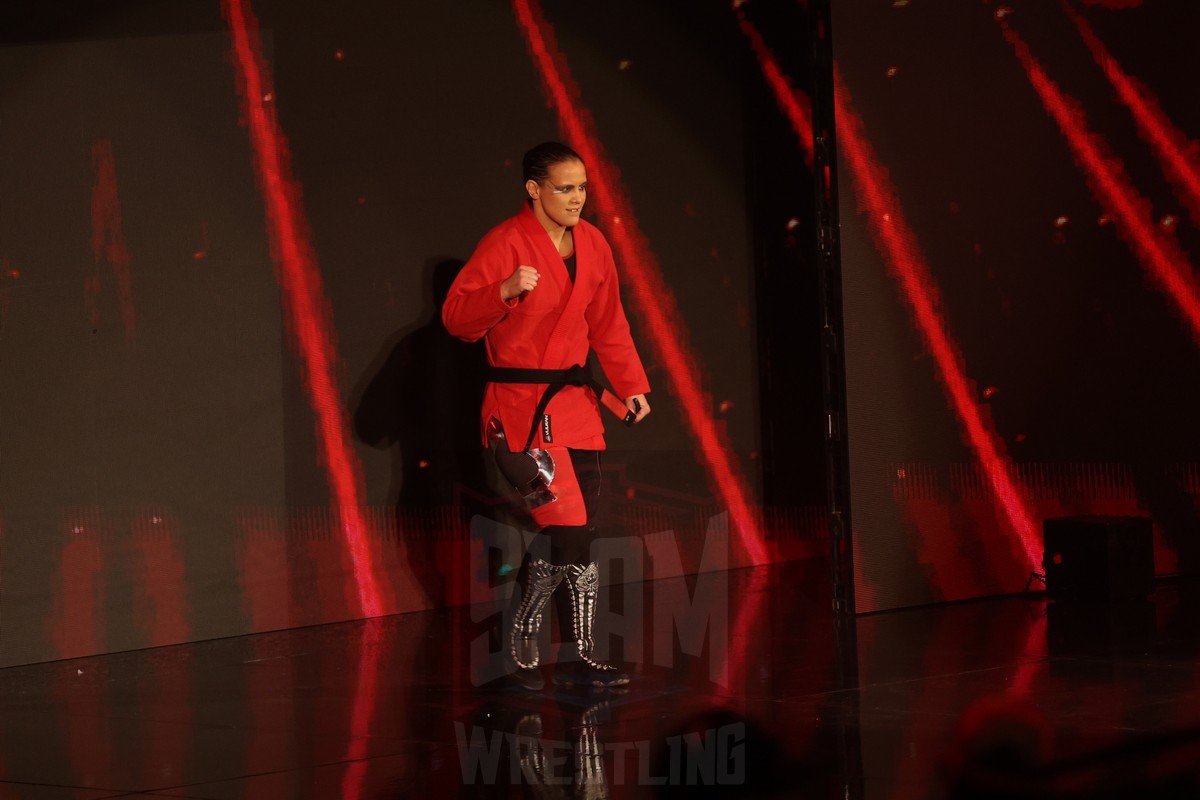
Shayna Baszler at WWE Monday Night Raw at the MVP Arena, in Albany, NY, on December 4, 2023. Photo by George Tahinos, georgetahinos.smugmug.com
For the uninitiated, Bloodsport is a series of events promoted by Game Changer Wrestling (GCW), a high-profile US independent promotion which has worked occasionally with All Elite Wrestling (AEW). Bloodsport is presented as an offshoot of ‘traditional’ pro wrestling. Matches are contested in a ring without ropes or turnbuckles and end in a knockout or submission. Bloodsport is a spiritual successor to the old Japanese Pancrase and Union of Wrestling Forces International (UWFI) worked-shoot promotions, where competitors used a style derived from mixed martial arts. Bloodsport often features wrestlers like Barnett, Matt Riddle and now Baszler who have crossed over between MMA and pro wrestling. On April 4, 2023, Baszler is set to fight current TNA star Masha Slamovitch on a card that features Total Nonstop Action Wrestling (TNA), AEW and New Japan Pro Wrestling (NJPW) stars.
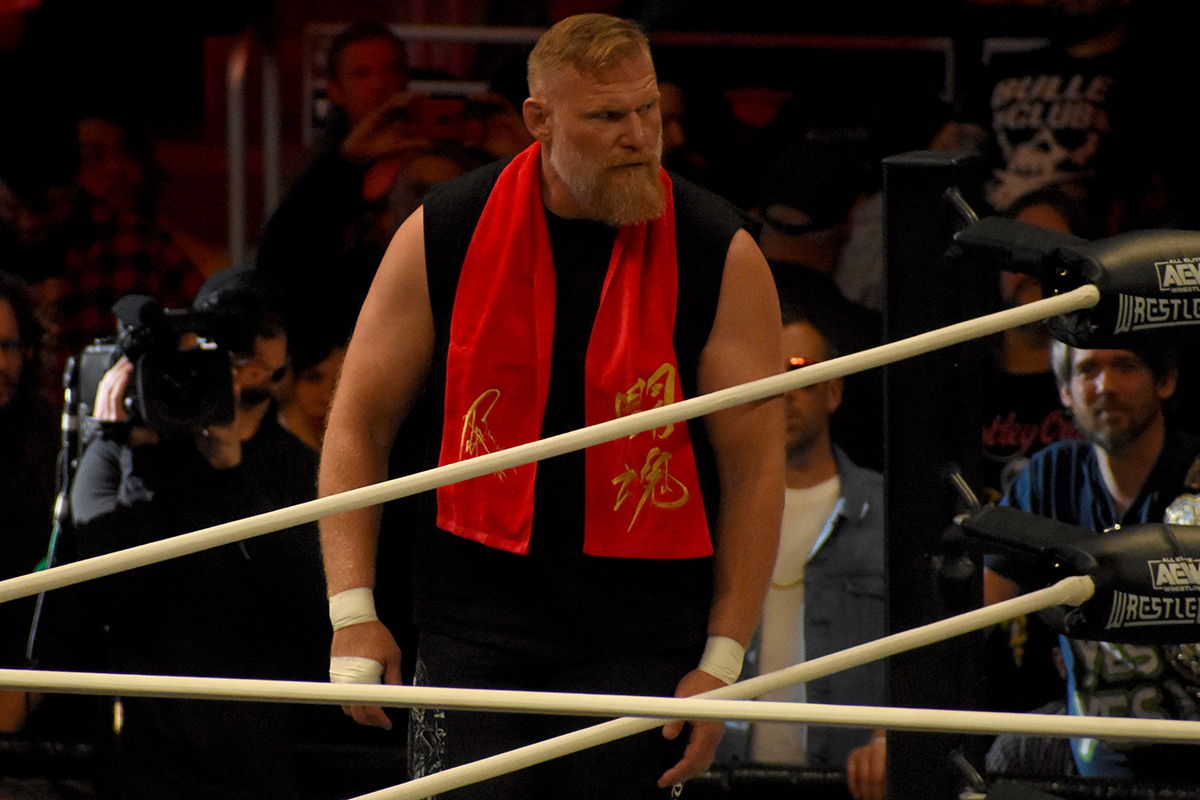
Josh Barnett at WrestleDream on Sunday, October 1, 2023, at Climate Pledge Arena in Seattle. Photo by Ben Lypka
As a side note, WWE tried to ape the worked shoot style on the eve of the COVID-19 pandemic when Shane McMahon introduced us to RAW Underground, and back in the 1990s they injured half the roster putting pro wrestlers into ‘real combat’ during the Brawl for All tournament. These experiments with a worked shoot presentation suggest WWE’s merger with the Ultimate Fighting Championship is for the best. I wonder whether Baszler’s appearance in a worked shoot promotion was cleared with the UFC side of TKO’s business. It’s easy dismiss the idea as ‘pro wrestling is pro wrestling’ and draw a distinction between the ‘real’ fights promoted by UFC and WWE’s performances but as the two brands develop their working relationship it’s fair to ask how open UFC might be to WWE collaborations that approach their turf (leaving aside the question of how legitimate some MMA contests may be. I’m still not over a blatantly fake Bellator match between Ken Shamrock and the late Kimbo Slice).
The fact that WWE would loan any of its stars out to other promotions during its busiest season might say more about Baszler’s position within the company than about a sea change in WWE booking policy. Baszler has been a steady part of the roster and was a fixture in the NXT women’s division. At one point she was booked as an unstoppable, long-reigning two-time champion. On the main roster she’s notched a few tag titles but apart from her initial dominant Elimination Chamber win and WrestleMania loss against Becky Lynch, she’s been a supporting player when she’s been featured at all. Despite her more fearsome appearance and sadistic in-ring style, she was displaced in her role as WWE’s resident female mixed martial artist by Ronda Rousey during her WWE tenure. In her early 40s Baszler has been paired with newer talent like Zoey Stark as more of a mentor. I wasn’t a big fan of Rousey’s work but she did bring more star power to the roster. Baszler has suffered by comparison.

Photo by George Tahinos at the Barclays Center in Brooklyn from WWE SummerSlam on Sunday, August 19, 2018.
One of the more recent examples of WWE sending talent to other promotions took place last January. Shinsuke Nakamura defeated the Great Muta on a Pro Wrestling NOAH show as part of Muta’s retirement tour. While Nakamura has mostly been used as a mid-carder in WWE to the consternation of international fans, the match against Muta was a big deal — even bigger since unlike most of the instances in this column, Nakamura was openly promoted and the match was mentioned repeatedly on WWE TV. On the surface, if there was quid pro quo involved, it may have been Nakamura’s victory — wherein he ‘stole’ Muta’s mist before spraying him en route to the win (and has since incorporated the dreaded Asian trope as part of his offence in his feud with Cody Rhodes). Also following Muta’s retirement in a match against AEW’s Darby Allin and Sting, he appeared on WWE TV for the first time as part of the 2023 Hall of Fame class.
A few months before Nakamura went on his walkabout, in October 2022 WWE was negotiating for the return of Karl Anderson and Luke Gallows, who had been splitting their time between TNA and NJPW. Gallows and Anderson were one of many acts that got over in Japan but never quite translated to WWE — or at least WWE’s key decision makers. In WWE, if Anderson wrestled as a singles competitor he was treated almost as enhancement talent. In NJPW he held multiple singles and tag team titles. At the time he re-signed with WWE he was the NJPW NEVER Openweight Champion. The NEVER title is typically defended on NJPW undercards — it was originally meant as a showcase for newer, younger talent but has become linked to older, grittier acts. In any case, Anderson’s signing with WWE while holding the title posed a challenge, one that WWE and NJPW resolved in surprisingly amicable fashion. Anderson was allowed to fulfil his remaining dates with NJPW, including dropping the title to Tama Tonga in January 2023 at NJPW’s biggest show of the year, Wrestle Kingdom.
At first blush, WWE did not appear to demand compensation from Pro Wrestling NOAH or NJPW for the use of ‘their’ talent, which is especially interesting given NJPW’s ongoing ‘Forbidden Door’ relationship with AEW and TNA/Impact. Cynically, lending out two wrestlers to promotions where they would be seen as big stars while being bit players in North America might serve a different purpose: WWE allowed these trips knowing that several key NJPW wrestlers including Will Osprey and Kazuchika Okada were approaching the end of their contracts. WWE, Osprey and Okada were also likely aware of the challenges that other NJPW talent experienced in WWE (Lord Tensai, anyone?) and may have wanted to present Osprey and Okada with a kinder, gentler view of how their careers might go in the US. If that was WWE’s gambit, it doesn’t look like it succeeded in the short term: Okada and Osprey signed with AEW. Nakamura has yet to find a place on this year’s WrestleMania card. Anderson is cooling his heels in NXT under the watchful eye of Lord Tensai.
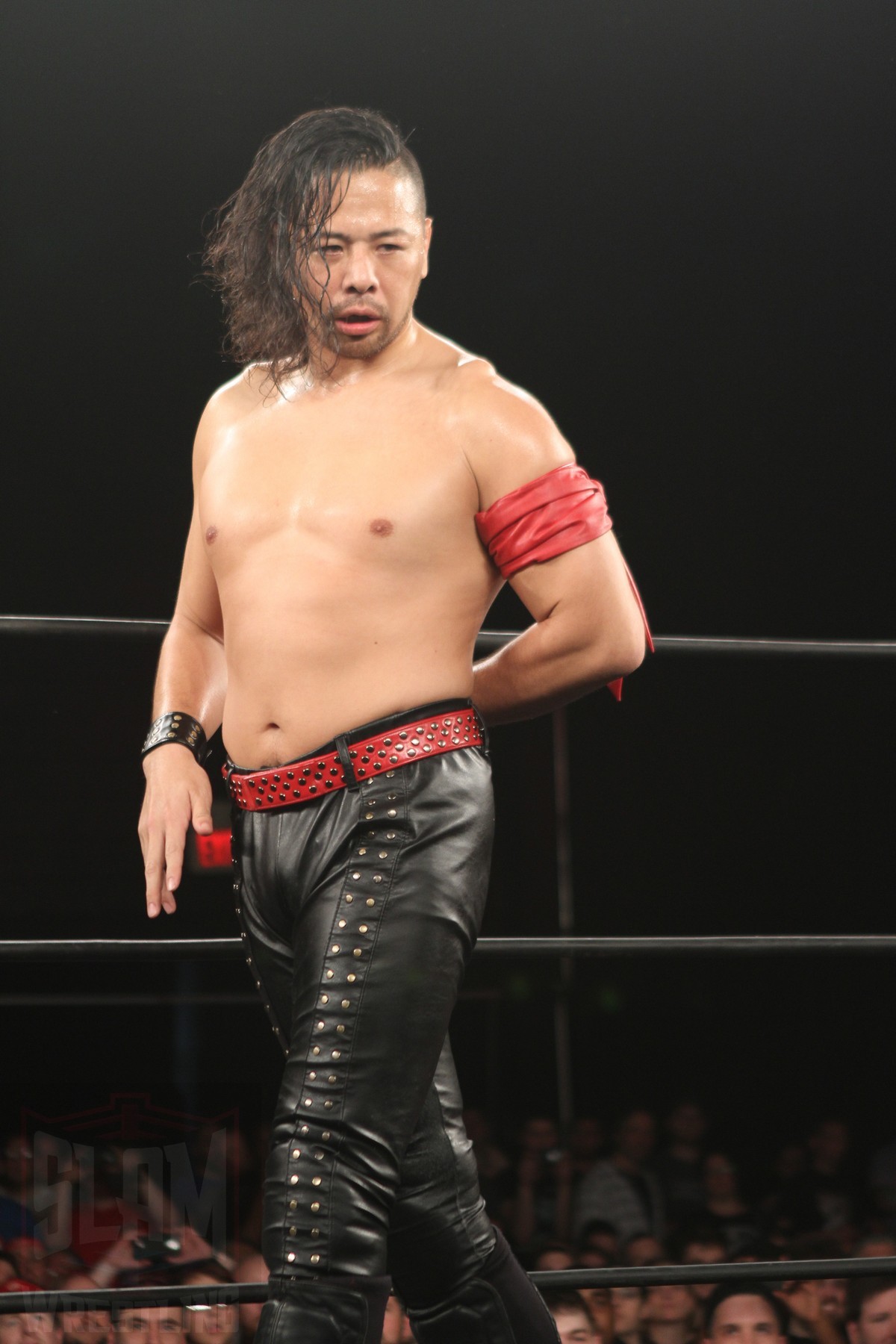
Shinsuke Nakamura in Ring of Honor. Photo by George Tahinos, georgetahinos.smugmug.com
As fun as these recent sojourns may be, WWE has quietly encouraged talent to work outside the promotion for a while now — especially if they’re still in WWE’s developmental system, have international experience or their appearances help firm business ties between WWE and potential feeder organizations. Most recently, William Regal’s son Charlie Dempsey fought on an All-Japan Pro Wrestling (AJPW) card. Two years ago, current NXT World Champion Ilja Dragunov made a surprise appearance at a PROGRESS Wrestling card in the UK. In September 2018 Hideo Itami (aka KENTA) wrestled for Pro Wrestling NOAH, beating Nakamura to the punch. Also in 2018, Street Profits Montez Ford and Angelo Dawkins wrestled several times for EVOLVE as part of WWE’s working relationship with that promotion. The Street Profits even captured the EVOLVE tag team championship. German promotion Westside Xtreme Wrestling (which had its own relationship with WWE) hosted current Intercontinental Champion Gunther/WALTER on its 21st Anniversary show in 2021.
For years WWE has allowed personnel who were mostly inactive in-ring to work selected independent dates. Jerry ‘The King’ Lawler has probably made the most liberal use of this policy, doing indy shots and keeping his home/hobby Memphis promotion afloat throughout his WWE tenure — even after he suffered a heart attack on-air during RAW. In 1992, his United States Wrestling Association (USWA) promotion hosted a WWF ‘invasion’ angle which saw Lawler defend his USWA title against the likes of Owen Hart, Randy Savage, Papa Shango and Tatanka. This collaboration would continue for years. Sid, Razor Ramon, Koko B. Ware and Ahmed Johnson all held the USWA’s main championship as a result. Even Vince McMahon, who at the time was still playing an announcer without acknowledging his ownership on WWF TV, got into the act. He appeared on USWA TV as a prototypical version of his evil ‘Mr. McMahon’ character.
Flying WWE’s flag, Lawler launched his own invasion of Paul Heyman’s Extreme Championship Wrestling (ECW) a few years later. In 1997, following ECW’s ‘taking over’ an episode of Monday Night Raw, Lawler made his ECW debut. He appeared after the main event of WrestlePalooza ’97, which saw Tommy Dreamer vanquish longtime foe Raven (more on him later). As an emissary of cartoonish wrestling Lawler was booed out the building before he delivered a diatribe claiming that he would poach ECW talent and put the company out of business.
But wait, there’s more!
In September 1997 then-WWF Champion Bret Hart fought ECW-contracted legend Terry Funk in one of Funk’s many retirement matches. The match took place in Amarillo, Texas, at an event called WrestleFest which was produced by ECW. It featured several ECW performers along with WWF stars like the Bushwhackers, Jake ‘the Snake’ Roberts and Mick Foley as Mankind (who likely appeared because of his deep real-life friendship with Funk). Funk’s retirement lasted 11 days. The card lives on in infamy as part of the 1999 documentary Beyond the Mat which captured Funk and Hart’s preparations for the match and Dennis Stamp’s attempts to get booked on the show — and the best wrestler workout regimen this side of Buddy Rose’s ‘Blow Away’ Diet.
One of my all-time favorite female wrestlers (whose autobiography you should definitely buy) is Madusa Miceli. In the late 1980s-90s Miceli worked an extremely technical and athletic style at a time when most American female wrestlers got by on weak punches and hair pulling. She was exciting and credible in a way that left her American opponents in the dust but found suitable competition in Japan. Miceli so outclassed her US opponents that throughout her reigns as WWF Women’s Champion under the name Alundra Blayze the federation had to recruit a series of Japanese opponents to fight her. In 1994, Blayze defended her title on an AJPW show against Bull Nakano. In fairness, Nakano had also been signed by WWE.
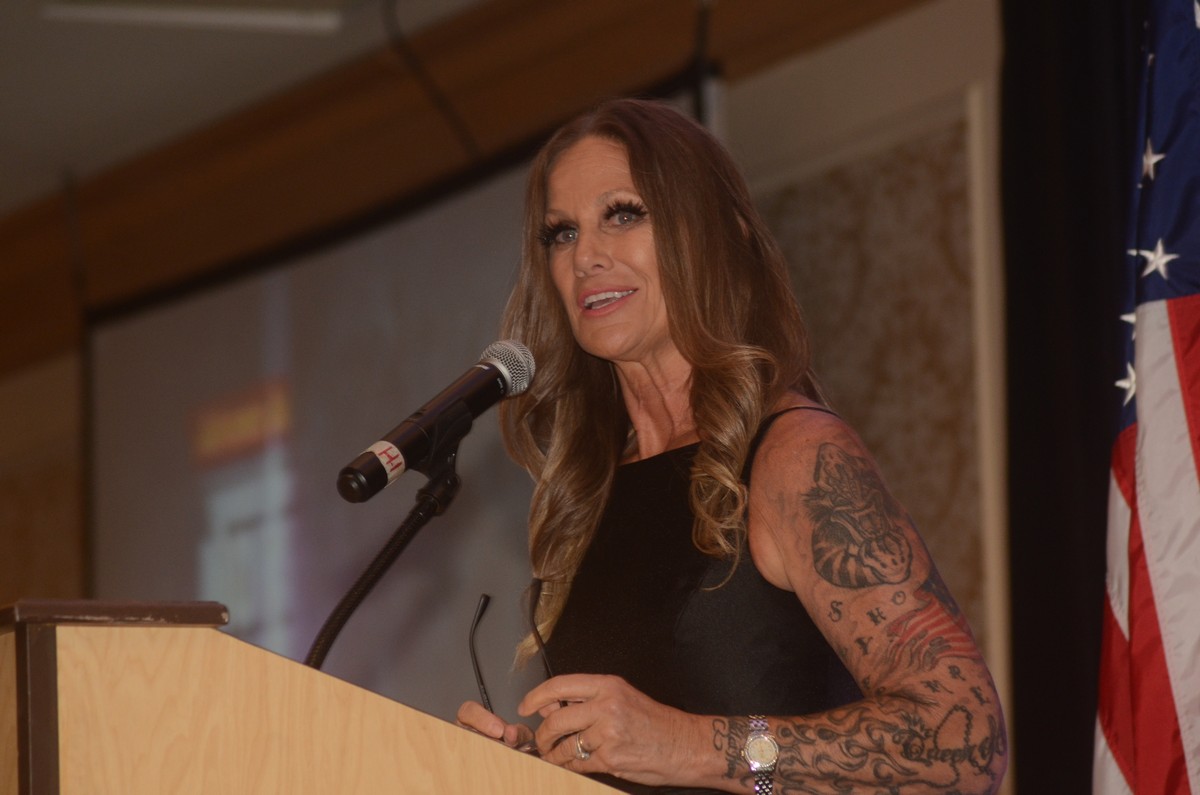
Iron Mike Mazurki Award winner “Madusa” Debrah Miceli talks at the Cauliflower Alley Club banquet at the Gold Coast Hotel & Casino in Las Vegas, Nevada, Wednesday, September 15, 2021. Photo by Brad McFarlin
The 1990s were a busy time for side hustles. In 1993, Hulk Hogan (still champion but clearly on his way out of the WWF) wrestled a series of matches in Japan for NJPW. One match against the Great Muta has become a favorite among Hogan advocates, as Hogan worked at a pace and employed moves that American fans rarely if ever saw. Hogan has long bristled at criticisms about his ring work. He claims to be as fundamentally sound as the next wrestler, but was taught by his trainer Hiro Matsuda that for a big, muscled star like himself, less is more. Fellow bodybuilder and Matsuda graduate Lex Luger said the same thing. Less popular were Hogan’s comments at the time, where he stated that NJPW’s International Wrestling Grand Prix (IWGP) world championship was worth more than the WWF’s — which Hogan derided as a ‘toy’. In October 1997, one of the WWF’s biggest stars, the Undertaker wrestled Jinsei Shinaski, who had worked in WWE under the quasi-mystical Hakushi gimmick, on a Michinoku Pro card — purportedly as thanks for Taka Michinoku’s efforts to popularize WWE’s Light Heavyweight division.
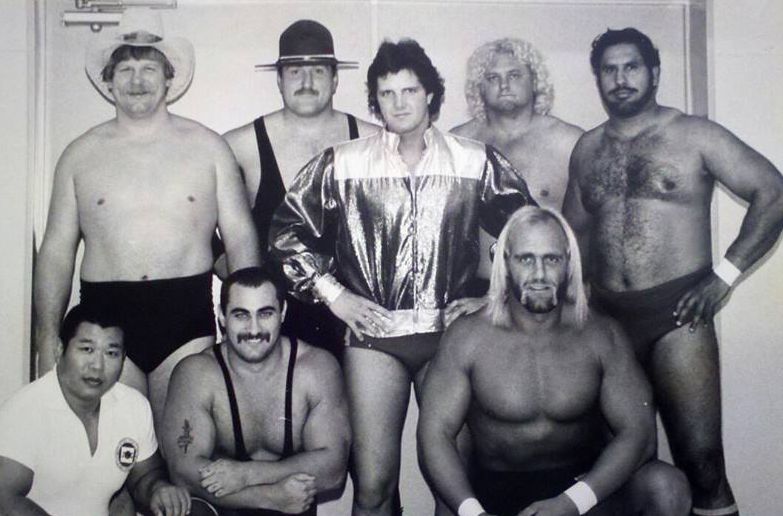
A 1980 tour of Japan included, clockwise from top left, Stan Hansen, Sgt. Slaughter, Chris Adams, Bobby Duncum Sr., Tiger Jeet Singh, Hulk Hogan, Mike Masters and referee Teruo Takahashi.
Occasionally, WWE loaned out talent for reasons that go beyond pro wrestling. Between 1998 and 2001 an annual series of events were held in Ohio to benefit the late Brian Pillman’s children. At a time when the Monday Night Wars were in full swing, these events grew to see cooperation between the National Wrestling Alliance (NWA), WWE, World Championship Wrestling (WCW) and ECW along with Ohio Valley Wrestling (OVW), local and indy wrestlers. The first show saw WCW’s Chris Benoit and Chris Jericho main event. It took place without WWE’s involvement, but subsequent shows featured the likes of Mick Foley, D’Lo Brown and the Road Dogg. A 2000 match between Chris Benoit and an in-recovery Steven ‘William’ Regal is credited as the start of Regal’s comeback and eventual status as WWE eminence grise. The Intercontinental Championship and ECW World Heavyweight Championship were both defended at the final Pillman Memorial show.
In November 2001, Eddie Guerrero was released from his WWF contract after being arrested for driving under the influence. He was rehired within a few months but in the meantime worked a number of independent dates, including the first ever Ring of Honor (ROH) show. Guerrero returned to the WWF in April 2002 but still managed to work a ROH tag team match into his schedule a few weeks after coming back.
ROH features in several of these examples, partly because of its resilience in a dire independent wrestling landscape, and partly because of the loyalty held by former talent who have gone on to prominent positions in wrestling promotions around the world. In February 2006 a rebuilding ROH was in danger of being snowed out of a show in Long Island. Former ROH champion and then-WWE developmental wrestler CM Punk heard about ROH’s issues in getting their own talent to the show and received permission to appear.
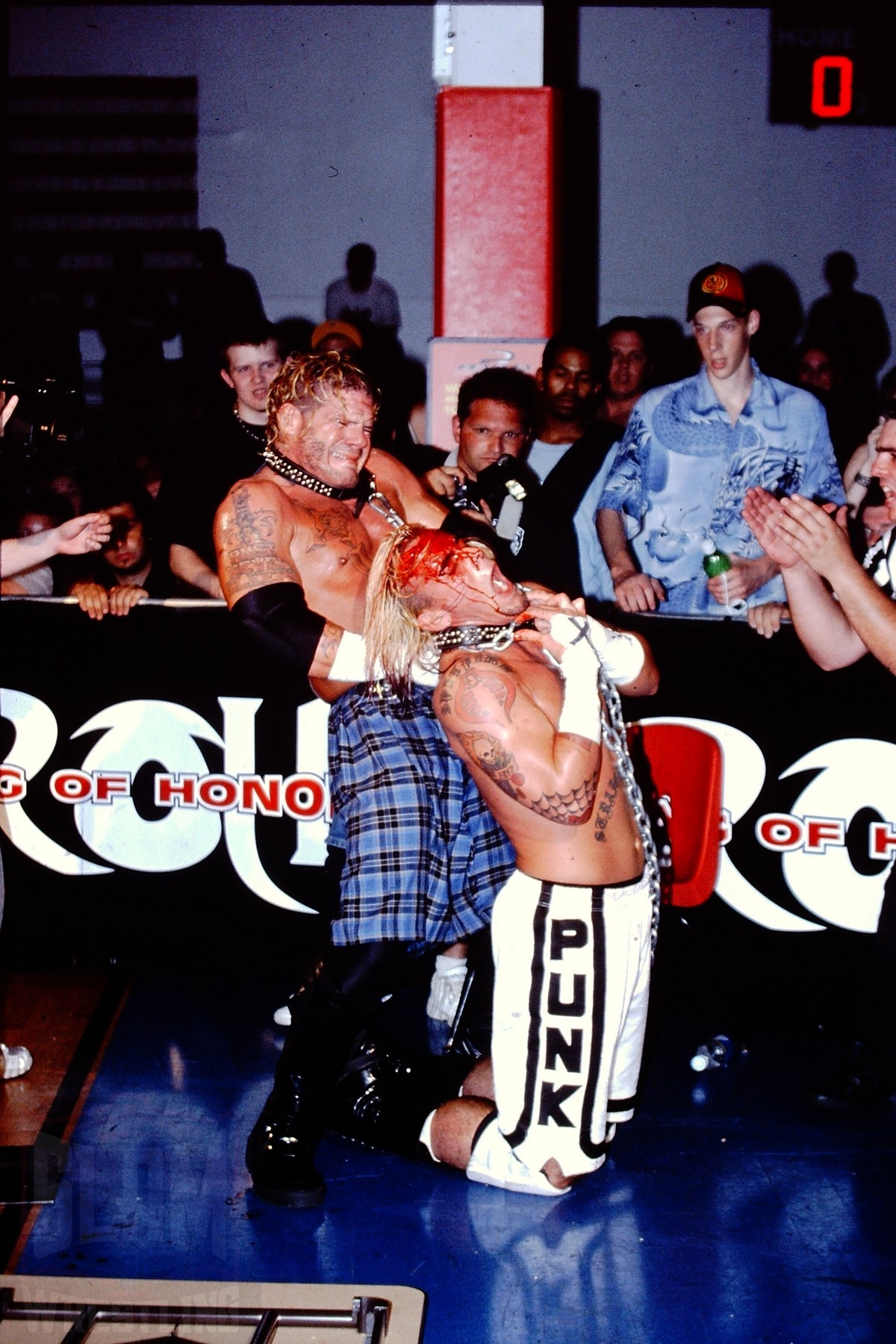
Raven versus CM Punk in Ring of Honor. Photo by George Tahinos, georgetahinos.smugmug.com
If the Pillman Memorial Shows highlight the brighter side of pro wrestling, an infamous ECW World Heavyweight Championship change illustrates the cutthroat nature of business. In April 2000 then-ECW champion Mike Awesome grew frustrated over a series of missed paychecks. He joined WCW and appeared on its TV shows without authorization, still holding the ECW title. WCW opted not to go the route the WWF had taken years before, when Ric Flair was introduced to WWF audiences complete with the WCW title — one of many missed opportunities coming out of this story. In any case WCW agreed to let their new roster member return to ECW for the express purpose of passing the title on. So far, so good, right? Except here’s where the WWF comes in: ECW owner Paul Heyman negotiated a one-night appearance for former ECW champion (Taz) turned WWE performer (Tazz) to be the man to defeat Awesome: in other words, a WWF-contracted wrestler beat a WCW-contracted wrestler for the ECW Championship. I see this as one of the more surreal moments in wrestling history — one which is unfairly ignored by WWE’s shaping of pro wrestling’s narrative after buying out WCW and ECW. Sadly, the wrestlers involved all came out worse for the affair. Awesome was pushed heavily in his WCW debut but couldn’t play the same Monster Heel that dominated ECW. For one thing, he didn’t look so big ‘where the big boys play’ and for another, his move set (including a blind powerbomb out of the ring onto a table) was reckless enough that established stars wouldn’t go near him. Awesome would eventually become a comedy wrestler in WCW in a series of awful gimmicks, have a cup of coffee in the WWF following the Invasion angle, and would eventually take his own life. Taz had been introduced to WWF fans with a victory over undefeated Kurt Angle, but a clash with creative and Vince McMahon’s prejudice against shorter wrestlers meant he too was destined for comedy wrestler status before injuring his neck and retiring to become a color commenter for WWE, TNA and now AEW. The highlight of his WWE/ECW reign was a clean Monday Night Raw loss to champion Triple H.
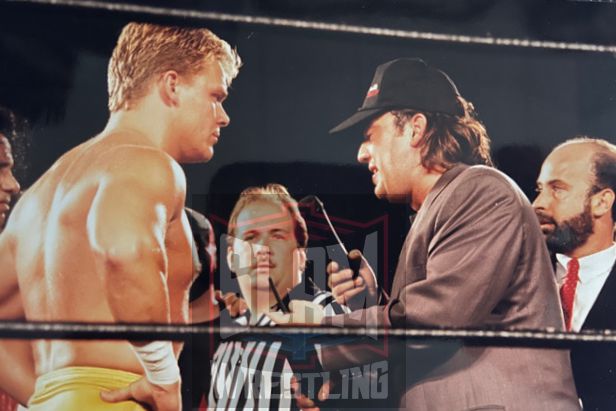
Shane Douglas and Paul Heyman (with Tod Gordon to the right) at an ECW event in1993. Photo by John Arezzi
In 2012 WWE allowed active wrestler Christian (Cage) to appear on a TNA pay per view to give a speech, in exchange for TNA permitting Ric Flair to accept his second WWE Hall of Fame induction as part of the Four Horsemen.
If you’ve been a Bryan Danielson fan since the beginning of his WWE tenure, you probably remember his debut with the NEXUS faction and immediate firing for choking announcer Justin Roberts with his own tie. This spot was a firable offense after an edict from Vince McMahon that ended ‘choking’ spots in the wake of the real-life Chris Benoit murder-suicide. Danielson got caught up in the heat of the moment and the company had no choice but to let him go. Many fans believe Danielson’s release was a work designed to help get the former ROH champ over as a babyface on his return two months after being sacked. Danielson won the US Title shortly after his return, and we know the rest of his story. Less publicized is the fact that on Danielson’s return to WWE he was allowed to honor his independent commitments, including an appearance with Dragon Gate USA. This match turned out to be particularly important: Danielson’s opponent was Jon Moxley, who caught WWE’s attention and would go on to become Shield member Dean Ambrose before joining AEW under his OG ring name. WWE would also develop a broader relationship with Dragon Gate USA through its sister promotion EVOLVE , which was featured on the WWE Network for several years before it was purchased outright by WWE in 2020.
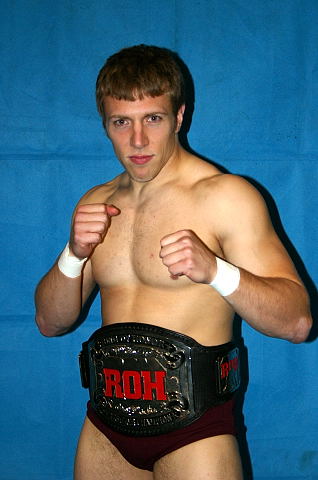
ROH champion Bryan Danielson.
WWE has always enforced its rules selectively, especially when it perceives a business advantage in breaking them or as a way to keep big ticket talent happy. Most of the examples in this column are lower-risk propositions for WWE. So long as WWE stars’ appearances aren’t widely broadcast and the guest promotion doesn’t take advantage of WWE’s intellectual property, loaning out midcarders or disused talent can’t go wrong.
Closest to home, residents of the Toronto suburb of Thornhill will soon celebrate the 25th anniversary of a card promoted by impresarios Jian and Page Magen. I’m reminded by my friend Elliott Silverstein about this show, which took place at the height of the Attitude Era. At the top of a standard indy show featuring local talent (and the Magen brothers in prominent positions) new WWE superstars Edge and Test main-evented at a swimming pool/community center and tore the house down. Apocryphally, their match is best remembered for disregarding the WWF’s repetitive, signature-spot based style in favor of a wild contest where Test unleashed a shooting star press. You’d have to ask the Magens if footage exists of this event, but the photocopied posters pop up every now and then on the internet.
For the most part, we’re long past the days where a touring champion ran the risk of some local competitor trying to shoot their way to a title victory. Brock Lesnar bucked this trend by fighting Mark Hunt on the UFC 200 pay per view in 2016. Lesnar and WWE ran a high risk of injury or embarrassment. Lesnar had fought successfully in UFC in between his WWE runs, but he’d also had his share of losses and UFC commenters were quick to note that “he didn’t like getting hit” — a contrast to how WWE portrayed Lesnar as a literal force of nature. UFC arguably needed Lesnar to juice their card. Higher profile fighters like Conor McGregor, Jon Jones and Ronda Rousey weren’t available. Lesnar won his fight in a decision, but the result was overturned after he tested positive for a banned substance. In the meantime, Lesnar was back in a WWE ring in time for SummerSlam, where he beat Randy Orton up so convincingly that Chris Jericho thought it was real and tried to fight Lesnar backstage.
If you think about it, it’s odd that WWE talent working other companies’ shows should be an issue. WWE has repeatedly rejected the idea that it’s in-ring talent are employees and has classified them as independent contractors. According to the Internal Revenue Service (IRS, not to be confused with a soon-to-be WWE Hall of Famer) the distinction between employees and independent contractors is critical. A business owner must determine whether the people who provide services to the business fall into one category or the other. A business owner (like WWE) must withhold and deposit income taxes, social security taxes and Medicare taxes on wages paid to an employee. No such obligations attach to independent contractors.
Per the IRS website [Independent contractor (self-employed) or employee? | Internal Revenue Service (irs.gov) Independent contractor (self-employed) or employee? | Internal Revenue Service (irs.gov)] in order to determine whether a person providing a service is an employee or an independent contractor, all information that provides evidence of the degree of control that the business exerts over the person, and the independence of that person must be considered.
According to the IRS, facts that provide evidence of the degree of control and independence fall into three categories:
- Behavioral: Does the company control or have the right to control what the worker does and how the worker does his or her job?
- Financial: Are the business aspects of the worker’s job controlled by the payer? (these include things like how worker is paid, whether expenses are reimbursed, who provides tools/supplies, etc.)
- Type of relationship: Are there written contracts or employee type benefits (that is, pension plan, insurance, vacation pay, etc.)? Will the relationship continue and is the work performed a key aspect of the business?
A business must weigh all these factors when determining whether a worker is an employee or independent contractor. Some factors may indicate that the worker is an employee, while other factors indicate that the worker is an independent contractor. Of note, the IRS website states that there is no “magic” or set number of factors that “makes” the worker an employee or an independent contractor and no one factor stands alone in making this determination. Also, factors which are relevant in one situation may not be relevant in another.
The IRS states that the keys are to look at the entire relationship and consider the extent of the right to direct and control the worker and to document each of the factors used in coming up with the determination.
The ‘independent contractor’ issue was raised in a lawsuit filed in the late 2000s by Scott ‘Raven’ Levy (which is why he’s unlikely to appear on WWE TV again, though maybe we’ll get a cameo during Paul Heyman’s WWE Hall of Fame speech), Christopher ‘Kanyon’ Kluscaertis and ‘Above Averge’ Mike Sanders.
In March 2009, a US Federal Judge dismissed Levy’s lawsuit. Levy argued that WWE wrestlers were denied economic benefits because they were ‘misclassified’ as independent contractors rather than employees. Levy claimed that WWE’s control over their salaries, worksites (i.e. the towns and venues where wrestlers would perform), training schedules, intellectual property, costumes and storylines meant they should be considered employees — which would have provided them with greater rights and benefits than those accorded to independent contractors. In addition to the above-noted tax consequences, employee status might have conferred other benefits that employees take for granted like health care, paid sick leave and vacation, which are in fact part of WWE office workers’ compensation. They’re considered employees.
Levy et al. sought class action status for their lawsuit, but a Senior US District Judge granted WWE’s motion to dismiss in federal court. The Judge found that the wrestlers signed contracts that acknowledged their status as independent contractors, regardless of the actual terms of those contracts. An appeal from this judgment failed — the plaintiffs would have argued that their relationship with WWE evolved from an independent contractor to an employee relationship, but the appeals court determined this argument to be futile in light of the wording on the face of the contacts.
While the lawsuit was unsuccessful, I always preferred this line of argument to the concussion-based lawsuits fronted by the likes of Konstantine Kyros (which are necessarily hopeless given the difficulty in proving that a wrestler whose WWF/WWE run is likely a small fraction of his or her total athletic career was nonetheless injured through the negligence of WWE). WWE’s version of independent contracting is a transparent attempt to avoid traditional employment law requirements. Their control over performers’ intellectual property, working dates and (yes) availability to work for other employers when not actively on WWE business has the hallmarks of a full employment relationship. The fact that for decades following the closure of WCW, WWE was the only American wrestling company of any scale gave talent even less room to negotiate their ‘independent contractor’ agreements and WWE greater control over their comings and goings. WWE contracts may well spell out that talent are ‘independent contractors’, but past a point that seems to violate principles of equity. I could draft a contract stating that my car is a giraffe, but that doesn’t make it so.
All that said, I think arrangements like Baszler’s are good for WWE and for wrestling as a whole. Used well, they give talent freedom to work in front of new and different audiences; to redefine themselves outside of their WWE image and hopefully to build fan interest in their return to a WWE ring. I’ve written before about wrestlers who needed to leave WWE outright in order to advance in the company on their return. Both WWE Championship challengers at this year’s WrestleMania did just that. Maybe this offers a way for wrestlers to develop as performers but keep WWE at an interested arms’ length. For talent on their way out of WWE, these excursions may provide opportunities to build business relationships for the next phase of their careers. Host promotions benefit from being able to advertise bigger stars and might be able to increase their exposure by working with bigger industry players. At least some of the value of these loans may be in the contacts wrestlers can make with possible opponents down the line.
And that’s what’s best for business.
TOP PHOTO: Shayna Baszler and Masha Slamovitch in a Bloodsport promo.
RELATED LINK

